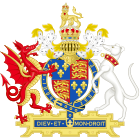Statute of Enrolments facts for kids

|
|
| Long title | An Act concerning Inrollments of Bargains and Contracts of Lands and Tenements. |
|---|---|
| Citation | 27 Hen. 8. c. 16 |
| Other legislation | |
| Relates to | Statute of Uses |
The Statute of Enrolments was an important law passed in 1536 by the Parliament of England. This law, also known as the Enrolment of Bargains of Lands, etc. Act 1535, was created to control how land was bought and sold.
It was closely connected to another law called the Statute of Uses, which was passed around the same time. Many people believed the Statute of Enrolments was added to fix something missing from the Statute of Uses. One main goal was to stop secret land deals. However, some historians today think King Henry VIII wanted this law to keep a clear list of who owned land in his kingdom.
This law mainly applied to land that people owned outright, called "freehold" land. But people quickly found a way around it. They would sell land for a short period, like a rental agreement, which is known as a leasehold. This loophole was officially accepted in 1621 by a court case called Lutwich v Mitton.
Contents
What Was the Statute of Enrolments?
The Statute of Enrolments was a special Act (a law made by the government) in England. It was designed to work with the Statute of Uses, another big law about land ownership. Some people, like a famous lawyer named Edward Coke, even called it just a "proviso" or an extra rule for the Statute of Uses.
This law was written very quickly, possibly because it was an emergency. Unlike most government laws, it didn't have a long introduction explaining why it was needed.
Why Was This Law Created?
Historians believe the Statute of Enrolments was created to solve a problem with land sales. Before this law, people could sell land secretly. This made it hard to know who truly owned what.
The new law said that after July 31, 1536, any sale of land had to be officially recorded. This recording had to happen in the main courts in Westminster or with local judges called Justices of the Peace. However, if a city or town already had its own rules for recording land sales, those rules could still be used.
How People Avoided the Law
Even though the law aimed to make land sales public, people found a clever way to get around it. The Statute of Enrolments only applied to land that was owned forever, known as "freehold" land. It did not apply to land that was rented or leased for a certain number of years, which is called "leasehold."
So, instead of selling land as freehold, people would simply sell it for a long period, like 99 years. This was not covered by the new law. In 1621, a court case called Lutwich v Mitton confirmed that this method was perfectly legal.
The Real Reason for the Law
For a long time, people thought the main reason for the Statute of Enrolments was to stop secret land deals. However, some modern experts, like Oxland, have a different idea. They believe King Henry VIII wanted this law so he could have a clear and accurate list of everyone who owned land in his kingdom. This would help him keep track of his subjects and their wealth.

